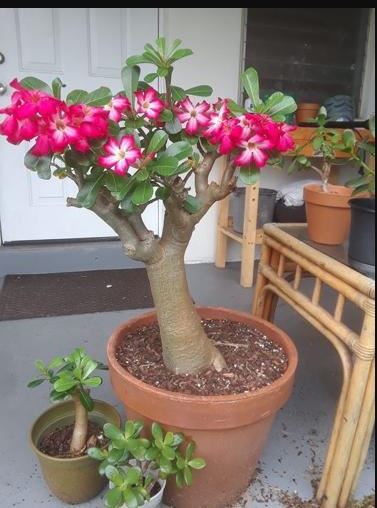Imagine vibrant pink, red, or white blossoms adorning a succulent stem, reminiscent of a miniature baobab tree – that’s the alluring beauty of the Desert Rose (Adenium obesum). But have you ever wondered how to make these desert jewels flourish faster, turning your garden into a vibrant oasis? If you’re nodding along, you’re in for a treat! This blog post is your roadmap to unlocking the secrets of rapid Desert Rose growth, whether you’re a seasoned gardener or just starting out.

How to Make Your Desert Rose Thrive: Growth Acceleration Tips
Desert roses (Adenium obesum) are stunning succulents known for their unique swollen stems (caudex) and vibrant blooms. If you’re looking to boost your desert rose’s growth and unleash its full potential, follow these essential tips:
1. Light Up Its Life:
Desert roses are sun-worshippers! They thrive in bright, direct sunlight. Aim for at least 6-8 hours of sunlight per day. If you’re growing your desert rose indoors, place it near a south-facing window or supplement with a grow light. Ample light encourages robust growth and abundant flowering.
2. Water Wisely:
While desert roses are drought-tolerant, they still need proper watering for optimal growth. Water deeply when the soil is dry to the touch, allowing excess water to drain completely. Avoid overwatering, as it can lead to root rot. In winter, reduce watering frequency, as desert roses enter a semi-dormant state.
3. Soil Matters:
Well-draining soil is crucial for desert rose health. Use a cactus/succulent mix or create your own by combining regular potting soil with perlite or coarse sand. This ensures good aeration and prevents waterlogging.
4. Feed Your Rose:
During the growing season (spring and summer), fertilize your desert rose with a balanced liquid fertilizer formulated for succulents. Follow the package instructions for dilution and frequency. Avoid fertilizing in winter.
5. The Right Pot Size:
Choose a pot that’s slightly larger than the root ball of your desert rose. A pot that’s too large can lead to overwatering, while a pot that’s too small can restrict growth. Repot every 2-3 years to refresh the soil and accommodate growth.
6. Temperature and Humidity:
Desert roses prefer warm temperatures (70-85°F/21-29°C) during the growing season. They can tolerate lower temperatures in winter, but avoid exposing them to frost. Maintain moderate humidity levels, especially indoors.
7. Pruning for Growth:
Regular pruning encourages branching and fuller growth. Prune during the growing season to shape your desert rose and remove any dead or damaged branches.
8. Pest and Disease Control:
Monitor your desert rose for common pests like mealybugs and spider mites. Treat any infestations promptly. Additionally, be vigilant about root rot, which can occur with overwatering.
9. Patience is Key:
Desert roses are relatively slow-growing plants. Don’t get discouraged if you don’t see immediate results. With consistent care and the right conditions, your desert rose will gradually reward you with healthy growth and beautiful blooms.
Additional Tips:
- Consider using a heat mat to warm the soil during cooler months, especially if you live in a cold climate.
- If your desert rose is leggy, prune it back to encourage branching and a more compact shape.
- Experiment with different varieties of desert roses to find ones that thrive in your specific environment.
Desert Rose FAQ: Your Burning Questions Answered
Q: How often should I water my Desert Rose?
A: Water your Desert Rose thoroughly when the soil is completely dry. In the growing season (spring and summer), this might be every 2-3 days, while in the dormant season (fall and winter), once a month might suffice. Always check the soil’s moisture before watering.
Q: My Desert Rose is leggy. What should I do?
A: Legginess often means your plant needs more sunlight. Ensure it gets at least 6-8 hours of direct sunlight daily. You can also prune the leggy stems to encourage bushier growth and a more desirable shape.
Q: How can I tell if my Desert Rose has root rot?
A: Signs of root rot include yellowing leaves, mushy stems, and a foul odor from the soil. If you suspect root rot, carefully remove the plant from its pot, trim away the affected roots, and repot it in fresh, well-draining soil.
Q: Why isn’t my Desert Rose blooming?
A: Several factors can affect blooming, including insufficient sunlight, overwatering, or lack of nutrients. Ensure your plant gets enough sunlight, water only when the soil is dry, and fertilize regularly during the growing season.
Q: Can I grow Desert Rose indoors?
A: Absolutely! Place it in a south-facing window for ample sunlight. You might need to supplement with grow lights during the winter months.
Q: My Desert Rose is dropping leaves. Is this normal?
A: Some leaf drop is normal during the dormant season. However, excessive leaf drop could indicate overwatering, underwatering, or temperature stress.
Q: Where can I buy Desert Rose seeds or plants?
A: You can find Desert Rose seeds or plants at most garden centers, nurseries, and online retailers.
Q: Is Desert Rose poisonous?
A: Yes, the sap of Desert Rose is toxic. Wear gloves when handling it and keep it away from pets and children.
Conclusions
By following these tips and providing the right care, you’ll be well on your way to growing a healthy, vibrant desert rose that will be the envy of your gardening friends. Remember, a little patience and attention go a long way in cultivating these stunning succulents.
Are you ready to transform your garden into a Desert Rose paradise? Share your experiences, questions, and photos in the comments below! Let’s create a community of Desert Rose enthusiasts and learn from each other’s successes.
Read Also:- Desert Rose Care: Your Complete Guide to Growing a Thriving Adenium

